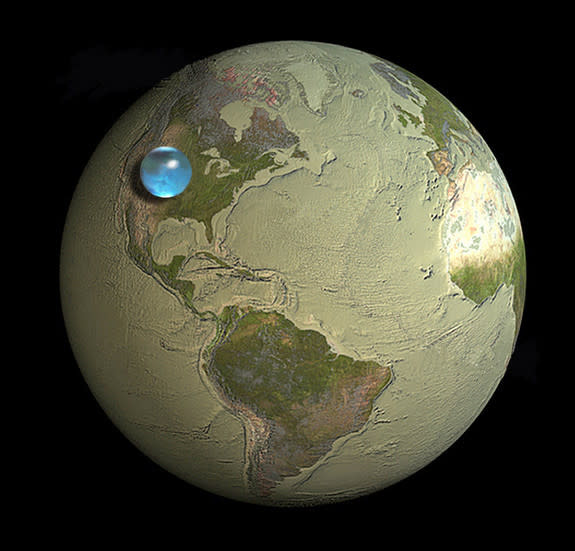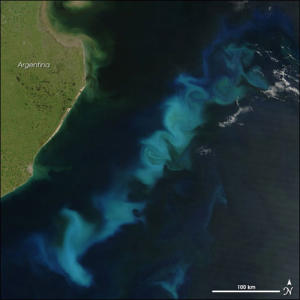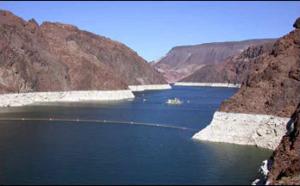
Editor's note: By the end of this century, Earth may be home to 11 billion people, the United Nations has estimated, earlier than previously expected. As part of a week-long series, LiveScience is exploring what reaching this population milestone might mean for our planet, from our ability to feed that many people to our impact on the other species that call Earth home to our efforts to land on other planets. Check back here each day for the next installment.
Water flows into Lake Powell, nestled between Utah and Arizona, from high in the Rocky Mountains via the Colorado River. More than 30 million people in seven states depend on the mighty Colorado for water to grow crops, fuel power plants and keep cities such as Las Vegas alive. But this year, the worst drought in a century has slowed the flow to a trickle.
In August, the federal Bureau of Reclamation cut, by 9 percent, the amount of water people in the southwestern United States could draw from Lake Powell. As states and counties squabble over their allotment of water in the coming years, hydroelectric plants (including the one on the Hoover Dam) could idle, and farmers are bracing for reduced crop production.In western Colorado, water is fed to farms through a network of ditches. Because water is allocated based on seniority, some of the newest farmers saw their water turned off in July, before the end of harvest, said Kate Greenberg, the Western organizer for the National Young Farmers Coalition, a group that supports young and independent farmers. Greenberg is also part of a working group looking for agricultural solutions to water shortages along the Colorado River.
While small farms managed to keep going by using private water supplies, some of the alfalfa farmers have been hard-hit, Greenberg said. Alfalfa requires a plentiful, steady supply of water, and is one of the most prevalent cash crops in Colorado, she said.
"If you have an alfalfa crop, it's ideal to get three cuttings a year, but in a dry year like this year, a lot of farmers have gotten one," Greenberg told LiveScience. "They get a third of their crop that they can bring to harvest."
The water woes plaguing the Southwest foreshadow a worldwide problem to come. Already, 2.7 billion people globally face at least some water scarcity, according to a 2012 study detailed in the journal PLOS ONE. Fights over water rights are causing political conflicts and instability in such places as the Nile valley and the Indian subcontinent. As population sizes rise, those conflicts will get more intense, according to a report by the National Intelligence Council, which advises the director of national intelligence for the United States about national security issues.
And the latest population models predict that 11 billion people will live on Earth by 2100, according to a United Nations report released last summer. Given that the existing population is already taxing water supplies in many regions, how will the planet provide for all the new people who will be here next century? [What 11 Billion People Means for the Planet]
"Water is the new oil," said Bill Davies, a plant biologist at the Sustainable Agriculture Center at Lancaster University in England. "People will be scrambling for water."
To provide for the planet, it's critical to understand the available water supply by creating detailed maps of where water is scarce or abundant, and improving water infrastructure, experts say. Making agriculture more efficient is also key. But even those measures may not be enough to provide for everybody. The global economy also needs to account for the true costs of water so that water-demanding products are made in water-rich areas and imported into more parched regions.
Measuring a finite resource
Right now, nobody even knows how much water is really in the ground. There are estimates at the global or the regional level — for instance, Californians pump about 14.5 billion gallons (54.9 billion liters) of groundwater a year, according to the National Groundwater Association (NGA).
But an individual farmer or people drawing from private wells may not know how much water is in their well until it runs dry or becomes contaminated with arsenic or nitrogen. In the United States, there are about 15.9 million water wells, and about 500,000 new wells are drilled every year for residential purposes, according to the NGA.
In most parts of the world (including much of the United States), individual well usage isn't metered, and anyone can pump groundwater without notifying an authority. Few places measure agricultural water usage.
Many places also rely on distant locales for their water sources, making sensible conservation policies tricky to enact on a local level. For example the Tigris River flows from Turkey to Iraq, so ensuring Iraq's supply requires conservation from Turkey — a political problem that requires international negotiations.
Because groundwater is the single biggest thing that moves around on the Earth's surface, new satellite systems can detect changes in Earth's gravity due to groundwater depletion. But because measurements rely on distant satellites in space, they have relatively poor spatial resolution, said David Maidment, a hydrologist at the University of Texas at Austin.
"It's a big regional measure. You can't say, 'This farmer here is stealing the water,'" Maidment told LiveScience.
Maidment and his colleagues are creating a way for local government, cities, states and countries around the world to share their water data. The goal is to get a detailed picture of the world's freshwater resources. Once that happens, officials will be able to decide how to allocate resources efficiently, he said.
Water-sparing plants
Of course, using more water efficiently also means not squandering it, particularly through wasteful agricultural practices.
Agriculture uses about 70 percent of the freshwater on the planet, said Giulio Boccaletti, managing director of the Global Freshwater Program at the Nature Conservancy.
Flood irrigation, a practice in which farmers drench fields with water from hoses or other sources, creates runoff that carries pesticides into local rivers and often out of the local watershed, Boccaletti told LiveScience. Other water evaporates into the atmosphere and is then carried away to distant parts of the globe. [5 Ways We Waste Water]
To stem those wasteful processes, farmers would need to cover crops with plastic to prevent evaporation and use drip irrigation to target water directly to a plant's roots.
Conversion to drip irrigation is happening, albeit slowly. In the United States, the National Resources Conservation Service offsets some costs of implementing water-sparing irrigation. However, many farmers don't know about these programs, and installing drip irrigation requires placing irrigation tape underground, which is labor-intensive and costly. This method may not work with crops in which tilling could frequently cut the underground infrastructure, Greenberg said. Only a fraction of farm acreage in Colorado is drip irrigated, although Greenberg said she sees more and more sprinkler systems replacing wasteful flood-irrigation systems.
In another solution, seawater or treated wastewater could replace freshwater for crops, Davies said.
Currently, the United States treats 70 percent of its wastewater but uses only about 4 percent, mostly for applications such as farming, according to a study in the September issue of the journal of Agricultural Water Management. But that number could increase as water becomes scarcer, the study cautioned. And Australia, the driest continent, has already commissioned several desalination plants along its eastern coastline.
Drought-prone regions will also have to shift crop production, relying on less-thirsty plants for agriculture, Davies said.
Tweaking plant growth
But changing how water is used may not be sufficient: Many climate-change models predict that some regions, such as the Southwest, may face more frequent droughts. Even today, water scarcity is a threat farmers routinely face. To provide for 11 billion people, farmers will have to know how to manipulate plants' own systems for dealing with drought.For instance, slightly water-stressed plants redirect their sugar formation into seeds and fruits at the expense of leaves and branches, which lose water easily. So, for example, farmers who grow wheat or grapes could increase their yield by actually watering their crops less at key times in the growing season, Davies said. [Dry and Dying: Images of Drought]
And cities could rely on massive glass towers to grow their food. Those futuristic buildings would lose no water to evaporation, would recycle nutrients from fertilizer and crops, and could rely, in part, on treated wastewater from a city, Davies said. Indoor farming is starting to transition from sci-fi to reality. At one of the first commercial vertical farms, a Singapore-based company called Sky Greens grows about a half-ton of bok choy and cabbage in three-story greenhouse towers.
Good news, bad news
In theory, there could be enough water for everyone on the planet. The trick is to use it intelligently and get it to the people in most dire need, Boccaletti said.
Ideally, water-rich areas, such as Argentina, should export items that require lots of water to produce (such as beef), while parched areas should devote their efforts to more water-sparing products, said Nico Grove, a researcher at the Institute for Infrastructure Economics and Management in Germany. Beef — which requires roughly 4,000 gallons (15,000 liters) of water for every 2.2 lbs. (1 kilogram) produced, according to the United Nations' UN-Water program — could be produced in the Amazon River Basin, the largest watershed in the world. In contrast, drier regions, such as the Middle East — which, from 2002 to 2009, pumped enough groundwater from the ground to fill the Dead Sea, according to a 2013 study in the journal Water Resources Research — could harvest fruits from drought-resistant crops such as xerophyte plants, cactus-related plants that are water-sparing.
For this water-transfer idea to work, an index of global water usage is needed, Grove said. One way to do this is by measuring virtual water, or how much water went into the production of an item. Using that metric in the economy could help countries shift their manufacturing and agricultural priorities to keep their production in line with their water resources. Some regions, such as the Middle East, could wind up importing most of their food based on this metric, he said.But improving the water situation takes money, political will and good governance. The richest countries may be able to spend their way out of water shortages, Boccaletti said, but the places that need water the most, such as sub-Saharan Africa, are least equipped to fix the problem. Those regions are caught in a bind: They need cheap, safe water to grow economically, but they lack the money to create new infrastructure — such as reservoirs, canals and dams — that would help them get that water, he said.
"Water is nature's currency for the entire economy," Boccaletti said. "Economic growth depends on us getting water for the right purposes."
People who rely on the Colorado River are facing that problem now. A June 2013 study in the journal Bulletin of the American Meteorological Society suggests that the low flows will worsen in the future. To protect the resource, everyone who relies on the river must agree on a new way to allocate its waters, Greenberg said.
Politicians, conservation groups and grassroots organizations have proposed several ideas, from far-fetched schemes, such as moving cellophane-wrapped icebergs to the coasts or diverting water from the Mississippi River, to politically unpopular solutions, such as decommissioning water-based power plants and limiting population growth.
Greenberg said that improving crop efficiency and creating positive incentives for farmers to save water are key. One option is water leases, in which farmers, anticipating a dry year, could temporarily fallow their land and lease their water to municipalities that need it. The laws should be changed as well, she said. Currently, the legal regime that governs water use for the Colorado River States, the "Laws of the Rivers," make water a use-it-or-lose it commodity, in which farmers risk losing water rights if they use less. Those rules discourage water conservation, she said.
But only time will tell whether measures like these will be enough, and whether people and governments will be willing to act. LINK





